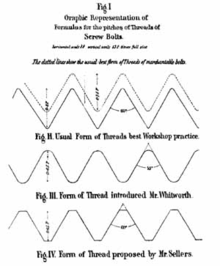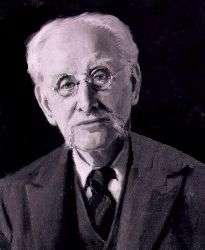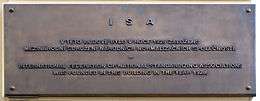International standard
International standards are technical standards developed by international organizations (intergovernmental organizations), such as Codex Alimentarius in food, the World Health Organization Guidelines in health, or ITU Recommendations in ICT[1] and being publicly funded, are freely available for consideration and use worldwide.
Purpose
International standards may be used either by direct application or by a process of modifying an international standard to suit local conditions. The adoption of international standards results in the creation of equivalent, national standards that are substantially the same as international standards in technical content, but may have (i) editorial differences as to appearance, use of symbols and measurement units, substitution of a point for a comma as the decimal marker, and (ii) differences resulting from conflicts in governmental regulations or industry-specific requirements caused by fundamental climatic, geographical, technological, or infrastructural factors, or the stringency of safety requirements that a given standard authority considers appropriate.
International standards are one way of overcoming technical barriers in international commerce caused by differences among technical regulations and standards developed independently and separately by each nation, national standards organization, or company. Technical barriers arise when different groups come together, each with a large user base, doing some well established thing that between them is mutually incompatible. Establishing international standards is one way of preventing or overcoming this problem.
History
Standardization

The implementation of standards in industry and commerce became highly important with the onset of the Industrial Revolution and the need for high-precision machine tools and interchangeable parts. Henry Maudslay developed the first industrially practical screw-cutting lathe in 1800, which allowed for the standardisation of screw thread sizes for the first time.[2]
Maudslay's work, as well as the contributions of other engineers, accomplished a modest amount of industry standardization; some companies' in-house standards spread a bit within their industries. Joseph Whitworth's screw thread measurements were adopted as the first (unofficial) national standard by companies around the country in . It came to be known as the British Standard Whitworth, and was widely adopted in other countries.[3]
By differences in standards between companies were making trade increasingly difficult and strained. The Engineering Standards Committee was established in London in as the world's first national standards body.[4][5] After the First World War, similar national bodies were established in other countries. The Deutsches Institut für Normung was set up in Germany in , followed by its counterparts, the American National Standard Institute and the French Commission Permanente de Standardisation, both in .[2]
International organizations

By , efforts were being made to standardize electrical measurement. An important figure was R. E. B. Crompton, who became concerned by the large range of different standards and systems used by electrical engineering companies and scientists in . Many companies had entered the market in and all chose their own settings for voltage, frequency, current and even the symbols used on circuit diagrams. Adjacent buildings would have totally incompatible electrical systems simply because they had been fitted out by different companies. Crompton could see the lack of efficiency in this system and began to consider proposals for an international standard for electric engineering.[6]
In , Crompton represented Britain at the Louisiana Purchase Exposition in St. Louis as part of a delegation by the Institute of Electrical Engineers. He presented a paper on standardisation, which was so well received that he was asked to look into the formation of a commission to oversee the process.[7] By his work was complete and he drew up a permanent constitution for the first international standards organization, the International Electrotechnical Commission.[8] The body held its first meeting that year in London, with representatives from 14 countries. In honour of his contribution to electrical standardisation, Lord Kelvin was elected as the body's first President.[9]

The International Federation of the National Standardizing Associations (ISA) was founded in with a broader remit to enhance international cooperation for all technical standards and specifications. The body was suspended in during World War II.
After the war, ISA was approached by the recently formed United Nations Standards Coordinating Committee (UNSCC) with a proposal to form a new global standards body. In , ISA and UNSCC delegates from 25 countries met in London and agreed to join forces to create the new International Organization for Standardization (ISO); the new organization officially began operations in .[10]
See also
- List of international common standards
- List of technical standard organisations
References
- "WHO | WHO guidelines approved by the Guidelines Review Committee". WHO. Retrieved 2019-08-21.
- Wang Ping (April 2011), A Brief History of Standards and Standardization Organizations: A Chinese Perspective (PDF), EAST-WEST CENTER WORKING PAPERS
- Gilbert, K. R., & Galloway, D. F., 1978, "Machine Tools". In C. Singer, et al., (Eds.), A history of technology. Oxford, Clarendon Press & Lee, S. (Ed.), 1900, Dictionary of national biography, Vol LXI. Smith Elder, London
- "BSI Group Annual Report and Financial Statements 2010, page 2" (PDF). Retrieved 2012-04-03.
- Robert C McWilliam. BSI: The first hundred years. 2001. Thanet Press. London
- Colonel Crompton, IEC Website Archived 2010-09-03 at the Wayback Machine
- Johnson, J & Randell, W (1948) Colonel Crompton and the Evolution of the Electrical Industry, Longman Green.
- Chris K. Dyer; Patrick T. Moseley; Zempachi Ogumi; David A. J. Rand; Bruno Scrosati Newnes (2010). Encyclopedia of Electrochemical Power Sources. p. 540. ISBN 9780444527455.
- IEC. "1906 Preliminary Meeting Report, pp 46–48" (PDF). The minutes from our first meeting. Retrieved 21 October 2012.
- Friendship among equals – Recollections from ISO's first fifty years (PDF), International Organization for Standardization, 1997, pp. 15–18, ISBN 92-67-10260-5, retrieved 26 December 2013
External links
